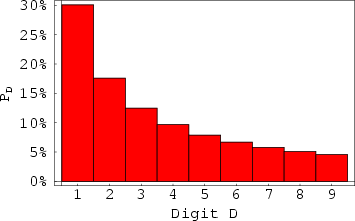
Answer to the Question 05/00
THE FIRST DIGIT
The question was:
Back side of the front cover of the Handbook of Chemistry and Physics
lists 18 important fundamental (dimensional) constants and
non-standard units such as speed of light, charge of an electron,
Stephan-Boltzmann constant, electron volt, etc.
Values of SEVEN out of 18 constants begin with digit 1.
Why is digit 1 so prevalent in that list?
Will the situation change if instead of MKSA (SI) units we will use, say,
inch, second, pound and electrostatic charge unit?
(5/2000) Many people contributed discussions/comments/references. Here are some names:
Dr. Fred Goesmann (e-mail
goesmann@linmpi.mpg.de,
Mike Salem (e-mail
mps5@po.cwru.edu),
Rasmus C. Egeberg (e-mail
regeberg@fysik.dtu.dk),
Ansgar Esztermann (e-mail
ansgar@thphy.uni-duesseldorf.de),
Andy Frohmader from Case Western Reserve University (e-mail
adf3@po.cwru.edu),
Carlos Ungil Gutierrez-Rave (e-mail
ungil@sol.unizar.es).
Each of the emails contained a different aspect of the solution, or told us
where such derivation can be found. Below we present a (mathematically
non-rigorous) solution of the question. (You are also advised to look at the
discussion of this problem where additional insights
and alternative derivations can be found.)
The answer: The prevalence of 1 as a first (significant) digit is dictated by the broad range
of numbers in the list, and has nothing to do with physics and the choice of units.
The solution:
Prevalence of digit 1 is not specific to the list mentioned in this question. Many
lists of physical properties will have 1 as their one of the most common first digit.
The only real requirement is - the list must include a very broad range, i.e the quantities
should range over several orders of magnitude.
(Physical constants listed in the Handbook range over many orders of magnitude (from
10-27 to 1023) in MKSA units.) Approximately we can say that
the list has no typical scale. Without knowing what exactly is included in the list
we can only guess, i.e. talk about probability distribution of the numbers.
We expect the probability distribution to be scale invariant, i.e. probability density
p(kx) should be proportional to probability p(x). (This means that the distribution
will be independent of the choice of units!) One can easily convince himself
that only p(x)~1/x has this property*. (We note that this probability density
is not normalizable. In reality the are some very remote cutoffs (minimal and maximal
numbers) which will determine the normalization prefactor.) Now we observe, that probability
P1 to find a number that begins with digit D=1, is a sum of probabilities
of number being in the intervals: 1< x< 2, 0.1< x< 0.2, 10< x< 20, 0.01< x< 0.02, ...
Similar, relation can be written for other digits. By performing such summations we
find that
PD=log10(1+(1/D))
In particular, this means that P1=0.30103, i.e. almost one third of
numbers begin with digit 1. Histogram of the probabilities is presented below:

From the derivation it must be clear that the law has nothing to do with physics, -
it it as valid for stock prices, numbers appearing in a newspaper, etc.
It was first noted by S. Newcomb (in 1881 in Amer J. Math. 4, 39(1881))
and investigated in detail by Frank Benford a physicist at the General Electric Company
(in Proc. Amer. Phil. Soc. 78, 551(1938)),
and, hence, is known as Benford's Law. Only recently, the law received rigorous formulation
and proof. For detailed description and references
see description of the law by
Eric W. Weisstein. (The above histogram was taken from there.)
See also the article
by Malcolm W. Browne on the applications to economics and fraud detection.
Some additional references are
http://www.newscientist.com/ns/19990710/thepowerof.html,
http://mathworld.wolfram.com/ZipfsLaw.html,
http://linkage.rockefeller.edu/wli/zipf/.
* This property can be proven as follows:
(1) Assume that p(kx)=f(k)p(x); then from normalization condition follows that f(k)=1/k.
(2) Since p(kx)=p(x)/k for any k, we can take k=1/x, and get p(x)=p(1)/x.
 Back to "front page"
Back to "front page"


 Back to "front page"
Back to "front page"